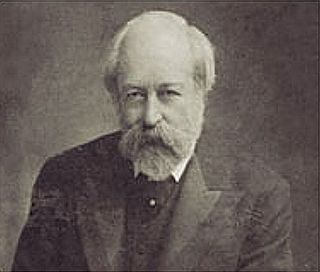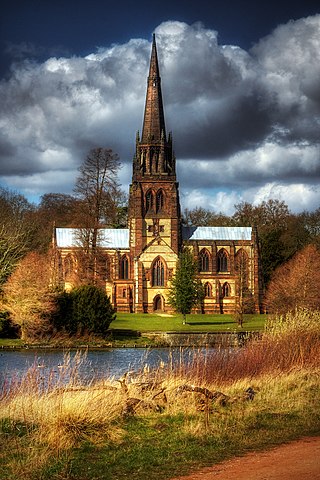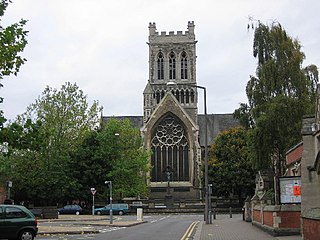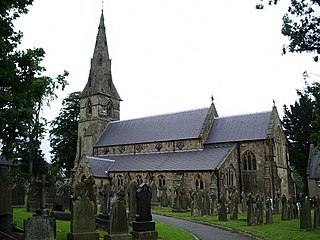
George Frederick Bodley was an English Gothic Revival architect. He was a pupil of Sir George Gilbert Scott, and worked in partnership with Thomas Garner for much of his career. He was one of the founders of Watts & Co.

The Church of St Agnes and St Pancras is in Ullet Road, Toxteth Park, Liverpool, England. It is recorded in the National Heritage List for England as a designated Grade I listed building, and is an active Anglican church in the diocese of Liverpool, the archdeaconry of Liverpool and the deanery of Toxteth and Wavertree. Pevsner described it as "by far the most beautiful Victorian church of Liverpool...an epitome of Late Victorian nobility in church design".

The Church of Saint John the Baptist is an active Anglican parish church in the Diocese of Liverpool and lies in the archdeaconry of Liverpool and the deanery of West Derby. It is situated on the corner of West Derby Road and Green Lane, in Tuebrook, Liverpool, England. It was built in the 1860s to a design by GF Botley and is Grade I listed, as a building of exceptional architectural interest. The site also contains the Victorian vicarage and a mortuary house, also by Botley and both Grade II listed. It is also the site of the Brockman Memorial Hall, an early venue of the Beatles.
Thomas Garner (1839–1906) was one of the leading English Gothic revival architects of the Victorian era. He is known for his almost 30-year partnership with architect George Frederick Bodley.

Burlison and Grylls is an English company who produced stained glass windows from 1868 onwards.

St John the Divine, Kennington, is an Anglican church in London. The parish of Kennington is within the Anglican Diocese of Southwark. The church was designed by the architect George Edmund Street in the Decorated Gothic style, and was built between 1871 and 1874. Today it is a grade I listed building.

Hugo Francis Meynell-Ingram was a Conservative Party politician in the United Kingdom. He was Member of Parliament (MP) for West Staffordshire from 1868 to 1871.

Hoar Cross Hall is a 19th-century country mansion near the villages of Hoar Cross and Hamstall Ridware, Staffordshire. England. The Grade II listed building is operated as a hotel and spa, and has facilities for conferences and weddings.

The Church of St. Mary the Virgin, Clumber Park, is an Anglican church in Clumber Park, Nottinghamshire, England.

Hoar Cross is a small village and civil parish in the Borough of East Staffordshire, situated approximately 7 miles (11 km) west of Burton upon Trent.

St Paul's Church is a Church of England parish church in Burton upon Trent, Staffordshire England. The church, on St Paul's Square and near the Town Hall, opened in 1874 and was designed by the architects James M. Teale and Edmund Beckett Denison. Later additions are by G. F. Bodley. The building is listed as Grade II*.

Forster and Andrews was a British organ building company between 1843 and 1924.

The Church of St Andrew is a Grade I listed church in the village of Clifton Campville, Staffordshire. It was built in the 13th and 14th centuries. The tall spire is a notable feature, visible from a great distance.

The Church of the Annunciation, Marble Arch, is a Church of England parish church in the Marble Arch district of London, England. It is dedicated to the Annunciation to the Blessed Virgin Mary. It is a Gothic revival building designed by Sir Walter Tapper and built in 1912–1913. It is a Grade II* listed building.

St John the Evangelist's Church is in Ribby Road, Kirkham, Lancashire, England. It is an active Roman Catholic parish church in the diocese of Lancaster. The church was designed by A. W. N. Pugin, and is recorded in the National Heritage List for England as a designated Grade II listed building.

St Paul's Church, Little Eaton is a Grade II listed parish church in the Church of England in Little Eaton, Derbyshire.

St Michael's Church, Kirk Langley is a Grade I listed parish church in the Church of England in Kirk Langley, Derbyshire.

St Michael and All Angels is a Grade II* listed Church of England parish church in Bedford Park, Chiswick. It was designed by the architect Norman Shaw, who built some of the houses in that area. The church was consecrated in 1880. It is constructed in what has been described both as British Queen Anne Revival style and as Perpendicular Gothic style modified with English domestic features. Its services are Anglo-Catholic.

Holy Trinity Church, Matlock Bath is a Grade II listed parish church in the Church of England in Matlock Bath, Derbyshire.

Emily Charlotte Meynell Ingram (1840-1904) was a British artist, traveller and the last resident of Temple Newsam House, Leeds. She was the daughter of Charles Wood, 1st Viscount Halifax.



























